The Centralization and Sharing of Information for Improving a Resilient Approach Based on Decision-Making at a Local Home Health Care Center
Abstract
Featured Application
Abstract
1. Introduction
2. Literature Review
3. Methods
3.1. Use Case Creation
- There are five caregivers performing five routes;
- Routes start at 7 a.m. from the health care center and end between 12 p.m. and 1 p.m. at the same location;
- There are 140 care visits to perform, which are requested by 140 patients (one visit per patient);
- When the caregivers have finished their routes, they can help their colleagues, if needed, or do administrative tasks at the health care center until 1 p.m.;
- Travel times are often short (usually less than five minutes) and are triangularly distributed more or less 30% around the average value;
- Care visit times are generally five minutes but can sometimes last 10 min. They are both subject to variations (such as travel times, with the same distribution) and to disruptions (whose distribution is detailed in the design of experiments);
- Time windows (i.e., time slot during which the caregiver must begin the care visit) last one hour for each visit;
- There is an early and late tolerance of five minutes, and if the caregiver arrives more than five minutes early, then they must wait before starting the care visit;
- The website “https://geodatamine.fr/ (accessed on 7 February 2023)” was used to generate random and unidentifiable addresses for patients (e.g., businesses, churches, parking spaces, etc.) around the city of Carmaux (France); the map is presented in Figure 2 on the left (1) where the library folium in Python was used to place the patients on a Leaflet map. The health care center was indicated in the city, and the 140 other addresses were randomly distributed to the patients. The website “https://openrouteservice.org/ (accessed on 7 February 2023)” was used by a query in a Python script to create a matrix of real travel times between patients.
3.2. Home Health Care
3.3. Design of Experiments
3.3.1. The Resilient Approaches
3.3.2. The Disruptions
3.3.3. The Schedule Solution
4. Results
5. Conclusions and Openings
- Promote the centralization and sharing of information between caregivers to improve mutual aid. The three resilient “2-X” sub-approaches outperform the “1-X” ones according to both the total number of late arrivals, the total time of late arrival, and especially the number of routes finishing before the target end time;
- In cases of mutual assistance between two caregivers, the helper must take the care visit closest to them. Among the three resilient sub-approaches studied, those whose rule is to take the next care visit closest to the helper (the “X-1” sub-approaches) are those that reduce the number of delays and the total time of delay.
Supplementary Materials
Author Contributions
Funding
Informed Consent Statement
Conflicts of Interest
References
- INSEE. D’ici 2070, Un Tiers des Régions Perdraient des Habitants—Projections de Population 2018–2070. Available online: https://www.insee.fr/fr/statistiques/6658362 (accessed on 22 March 2023).
- Fernandez, A.; Gregory, G.; Hindle, A.; Lee, A.C. A Model for Community Nursing in a Rural County. J. Oper. Res. Soc. 1974, 25, 231–239. [Google Scholar] [CrossRef]
- Gabrel, V.; Murat, C.; Thiele, A. Recent advances in robust optimization: An overview. Eur. J. Oper. Res. 2014, 235, 471–483. [Google Scholar] [CrossRef]
- Gendreau, M.; Laporte, G.; Séguin, R. Stochastic vehicle routing. Eur. J. Oper. Res. 1996, 88, 3–12. [Google Scholar] [CrossRef]
- Bertsimas, D.; Sim, M. The Price of Robustness. Oper. Res. 2004, 52, 35–53. [Google Scholar] [CrossRef]
- Cissé, M.; Yalçındağ, S.; Kergosien, Y.; Şahin, E.; Lenté, C.; Matta, A. OR problems related to Home Health Care: A review of relevant routing and scheduling problems. Oper. Res. Health Care 2017, 13–14, 1–22. [Google Scholar] [CrossRef]
- Di Mascolo, M.; Martinez, C.; Espinouse, M.-L. Routing and scheduling in Home Health Care: A literature survey and bibliometric analysis. Comput. Ind. Eng. 2021, 158, 107255. [Google Scholar] [CrossRef]
- Trautsamwieser, A.; Hirsch, P. Optimization of daily scheduling for home health care services. J. Appl. Oper. Res. 2011, 3, 124–136. [Google Scholar]
- Frifita, S.; Masmoudi, M. VNS methods for home care routing and scheduling problem with temporal dependencies, and multiple structures and specialties. Int. Trans. Oper. Res. 2020, 27, 291–313. [Google Scholar] [CrossRef]
- Lahrichi, N.; Lanzarone, E.; Yalçındağ, S. A First Route Second Assign decomposition to enforce continuity of care in home health care. Expert Syst. Appl. 2022, 193, 116442. [Google Scholar] [CrossRef]
- Yuan, B.; Liu, R.; Jiang, Z. A branch-and-price algorithm for the home health care scheduling and routing problem with stochastic service times and skill requirements. Int. J. Prod. Res. 2015, 53, 7450–7464. [Google Scholar] [CrossRef]
- Chaieb, M.; Jemai, J.; Mellouli, K. A decomposition—Construction approach for solving the home health care scheduling problem. Health Care Manag. Sci. 2019, 23, 264–286. [Google Scholar] [CrossRef] [PubMed]
- Bard, J.F.; Shao, Y.; Wang, H. Weekly scheduling models for traveling therapists. Socioecon. Plann. Sci. 2013, 47, 191–204. [Google Scholar] [CrossRef]
- Luna, F.; Cervantes, A.; Isasi, P.; Valenzuela-Valdés, J.F. Grid-enabled evolution strategies for large-scale home care crew scheduling. Clust. Comput. 2017, 21, 1261–1273. [Google Scholar] [CrossRef]
- Liu, R.; Yuan, B.; Jiang, Z. Mathematical model and exact algorithm for the home care worker scheduling and routing problem with lunch break requirements. Int. J. Prod. Res. 2017, 55, 558–575. [Google Scholar] [CrossRef]
- Heching, A.; Hooker, J.N.; Kimura, R. A Logic-Based Benders Approach to Home Healthcare Delivery. Transp. Sci. 2019, 53, 510–522. [Google Scholar] [CrossRef]
- Bard, J.F.; Shao, Y.; Qi, X.; Jarrah, A.I. The traveling therapist scheduling problem. IIE Trans. 2014, 46, 683–706. [Google Scholar] [CrossRef]
- Akjiratikarl, C.; Yenradee, P.; Drake, P.R. PSO-based algorithm for home care worker scheduling in the UK. Comput. Ind. Eng. 2007, 53, 559–583. [Google Scholar] [CrossRef]
- Frifita, S.; Masmoudi, M.; Euchi, J. General variable neighborhood search for home healthcare routing and scheduling problem with time windows and synchronized visits. Electron. Notes Discrete Math. 2017, 58, 63–70. [Google Scholar] [CrossRef]
- Fikar, C.; Hirsch, P. A matheuristic for routing real-world home service transport systems facilitating walking. J. Clean. Prod. 2015, 105, 300–310. [Google Scholar] [CrossRef]
- Carello, G.; Lanzarone, E. A cardinality-constrained robust model for the assignment problem in home care services. Eur. J. Oper. Res. 2014, 236, 748–762. [Google Scholar] [CrossRef]
- Yalçındag, S.; Matta, A.; Sahin, E.; Shanthikumar, J.G. The patient assignment problem in home health care: Using a data-driven method to estimate the travel times of care givers. Flex. Serv. Manuf. J. 2016, 28, 304–335. [Google Scholar] [CrossRef]
- Kitano, H. Biological robustness. Nat. Rev. Genet. 2004, 5, 826–837. [Google Scholar] [CrossRef] [PubMed]
- Christopher, M.; Peck, H. Building the Resilient Supply Chain. 2004. Available online: https://dspace.lib.cranfield.ac.uk/handle/1826/2666 (accessed on 6 March 2023).
- Nikzad, E.; Bashiri, M.; Abbasi, B. A matheuristic algorithm for stochastic home health care planning. Eur. J. Oper. Res. 2021, 288, 753–774. [Google Scholar] [CrossRef]
- Zhan, Y.; Wang, Z.; Wan, G. Home service routing and appointment scheduling with stochastic service times. Eur. J. Oper. Res. 2021, 288, 98–110. [Google Scholar] [CrossRef]
- Shi, Y.; Boudouh, T.; Grunder, O. A robust optimization for a home health care routing and scheduling problem with consideration of uncertain travel and service times. Transp. Res. Part E Logist. Transp. Rev. 2019, 128, 52–95. [Google Scholar] [CrossRef]
- Cappanera, P.; Scutellà, M.G.; Nervi, F.; Galli, L. Demand Uncertainty in Robust Home Care Optimization. 2017. Available online: http://www.sciencedirect.com/science/article/pii/S0305048316309008 (accessed on 17 April 2018).
- Oyola, J.; Arntzen, H.; Woodruff, D.L. The stochastic vehicle routing problem, a literature review, part I: Models. EURO J. Transp. Logist. 2018, 7, 193–221. [Google Scholar] [CrossRef]
- Errico, F.; Desaulniers, G.; Gendreau, M.; Rei, W.; Rousseau, L.-M. A priori optimization with recourse for the vehicle routing problem with hard time windows and stochastic service times. Eur. J. Oper. Res. 2016, 249, 55–66. [Google Scholar] [CrossRef]
- Alves, F.; Pereira, A.I.; Barbosa, J.; Leitão, P. Scheduling of Home Health Care Services Based on Multi-agent Systems. In Highlights Pract Appl Agents Multi-Agent Syst Complex PAAMS Collect; Bajo, J., Corchado, J.M., Navarro Martínez, E.M., Osaba Icedo, E., Mathieu, P., Hoffa-Dąbrowska, P., del Val, E., Giroux, S., Castro, A.J.M., Sánchez-Pi, N., et al., Eds.; Springer International Publishing: Cham, Switzerland, 2018; pp. 12–23. [Google Scholar]
- Marcon, E.; Chaabane, S.; Sallez, Y.; Bonte, T.; Trentesaux, D. A multi-agent system based on reactive decision rules for solving the caregiver routing problem in home health care. Simul. Model. Pract. Theory 2017, 74, 134–151. [Google Scholar] [CrossRef]
- Yuan, B.; Jiang, Z. Disruption Management for the Real-Time Home Caregiver Scheduling and Routing Problem. Sustainability 2017, 9, 2178. [Google Scholar] [CrossRef]
- Mourtzis, D. Simulation in the design and operation of manufacturing systems: State of the art and new trends. Int. J. Prod. Res. 2020, 58, 1927–1949. [Google Scholar] [CrossRef]
- Zhang, L.; Pingaud, H.; Fontanili, F.; Lamine, E.; Martinez, C.; Bortolaso, C.; Derras, M. Balancing the satisfaction of stakeholders in home health care coordination: A novel OptaPlanner CSP model. Health Syst. 2023, 1–21. [Google Scholar] [CrossRef]
- Robinson, S. Simulation: The Practice of Model Development and Use; Bloomsbury Publishing: London, UK, 2014. [Google Scholar]
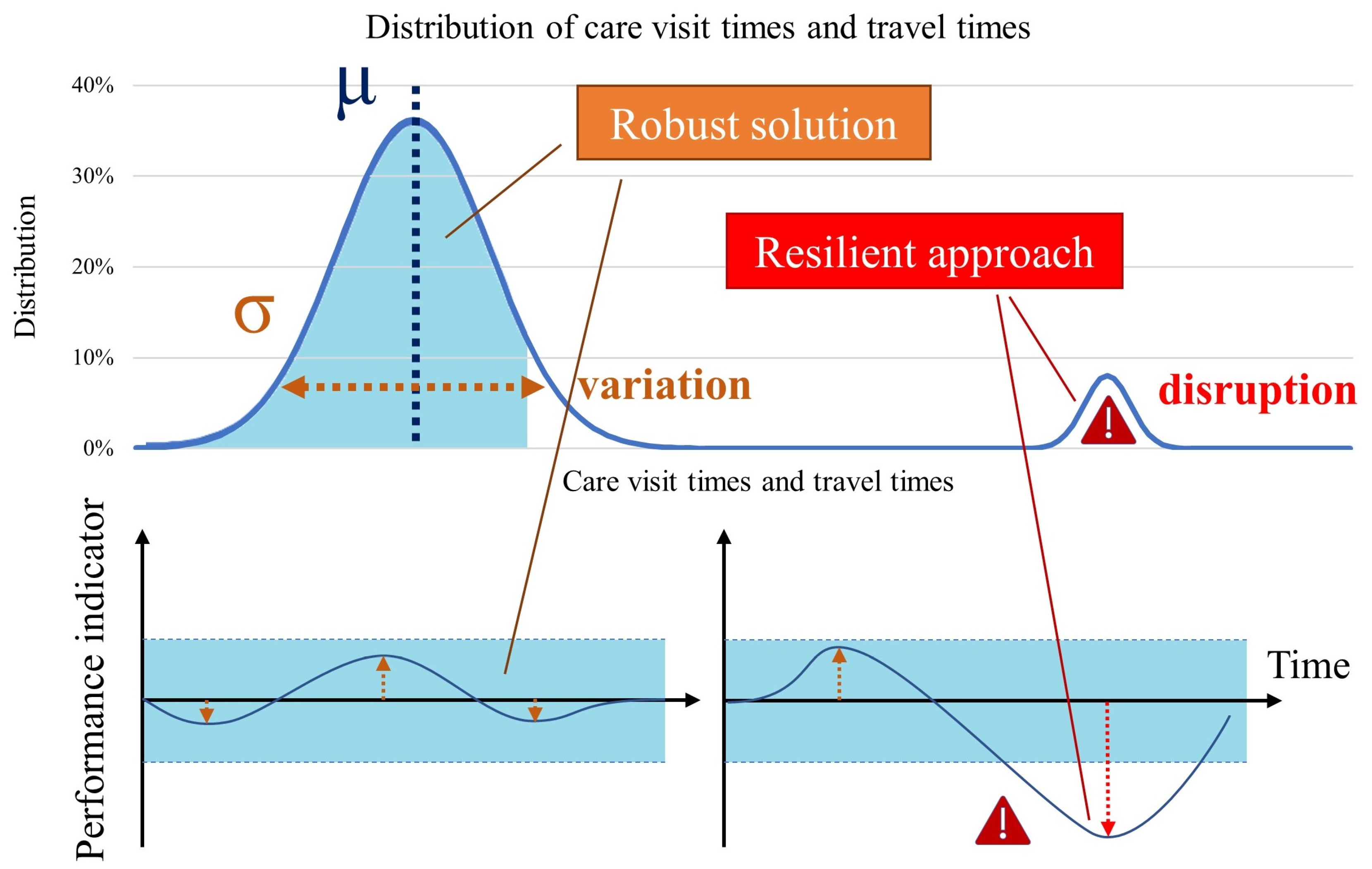
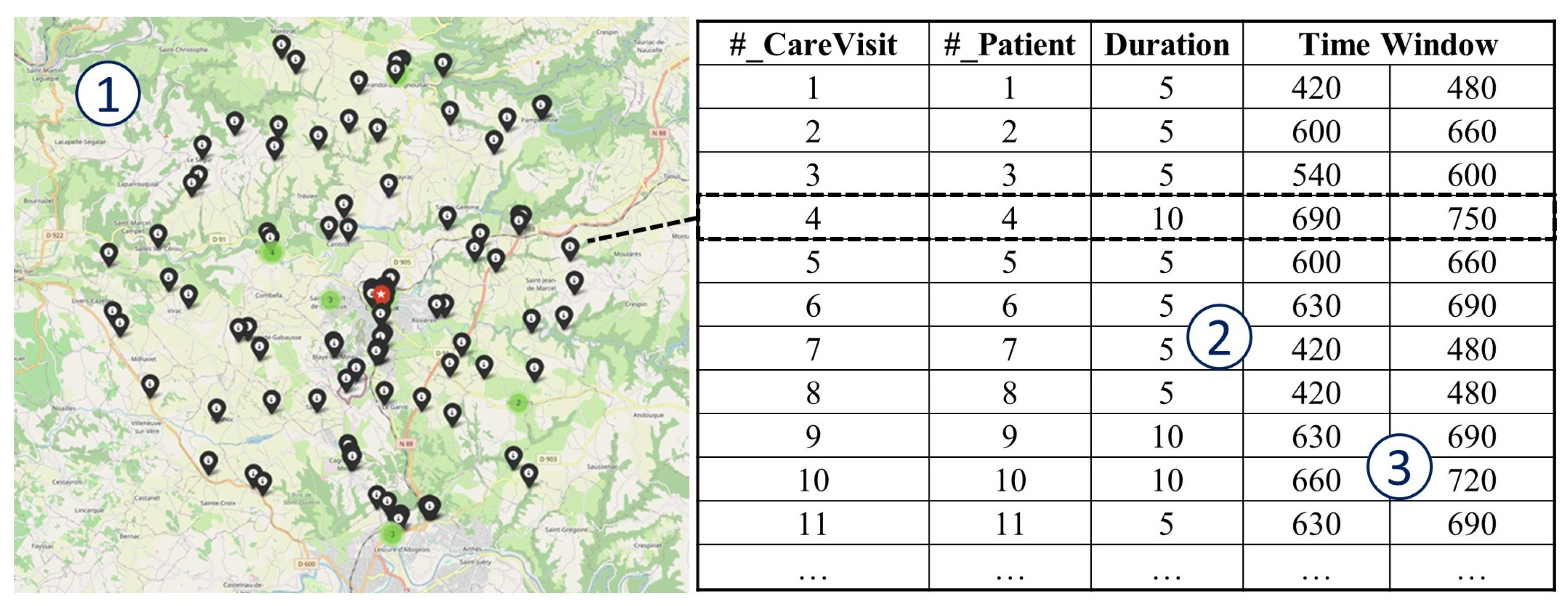
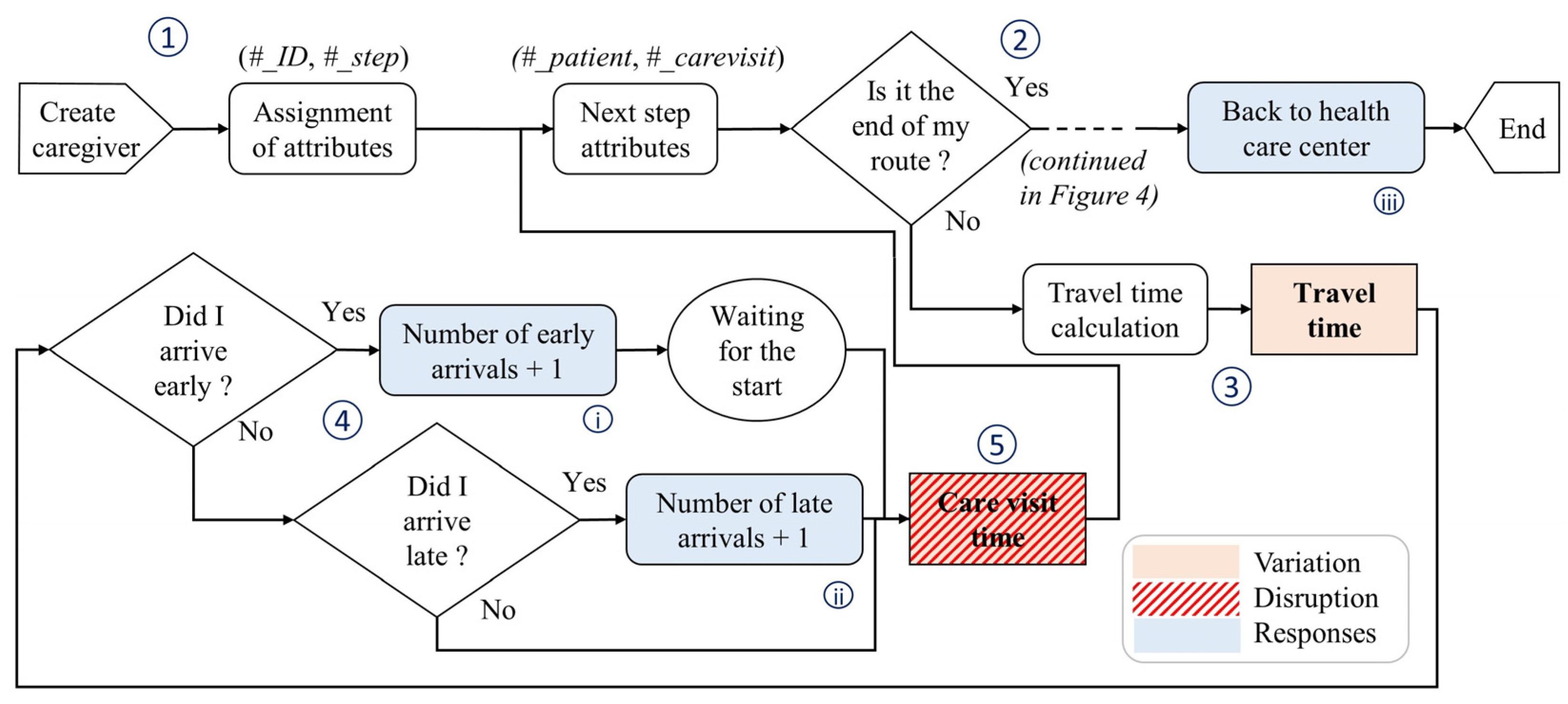
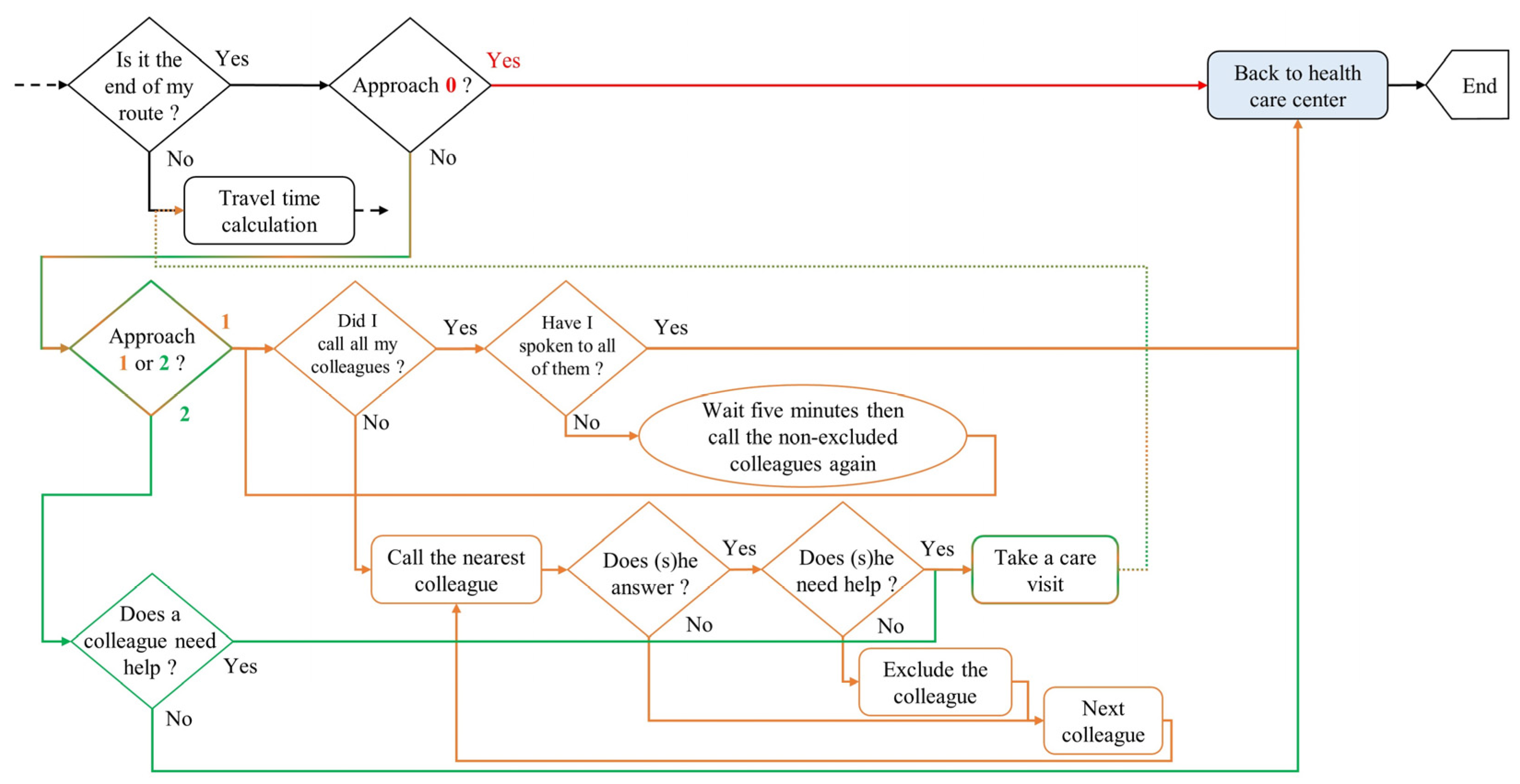
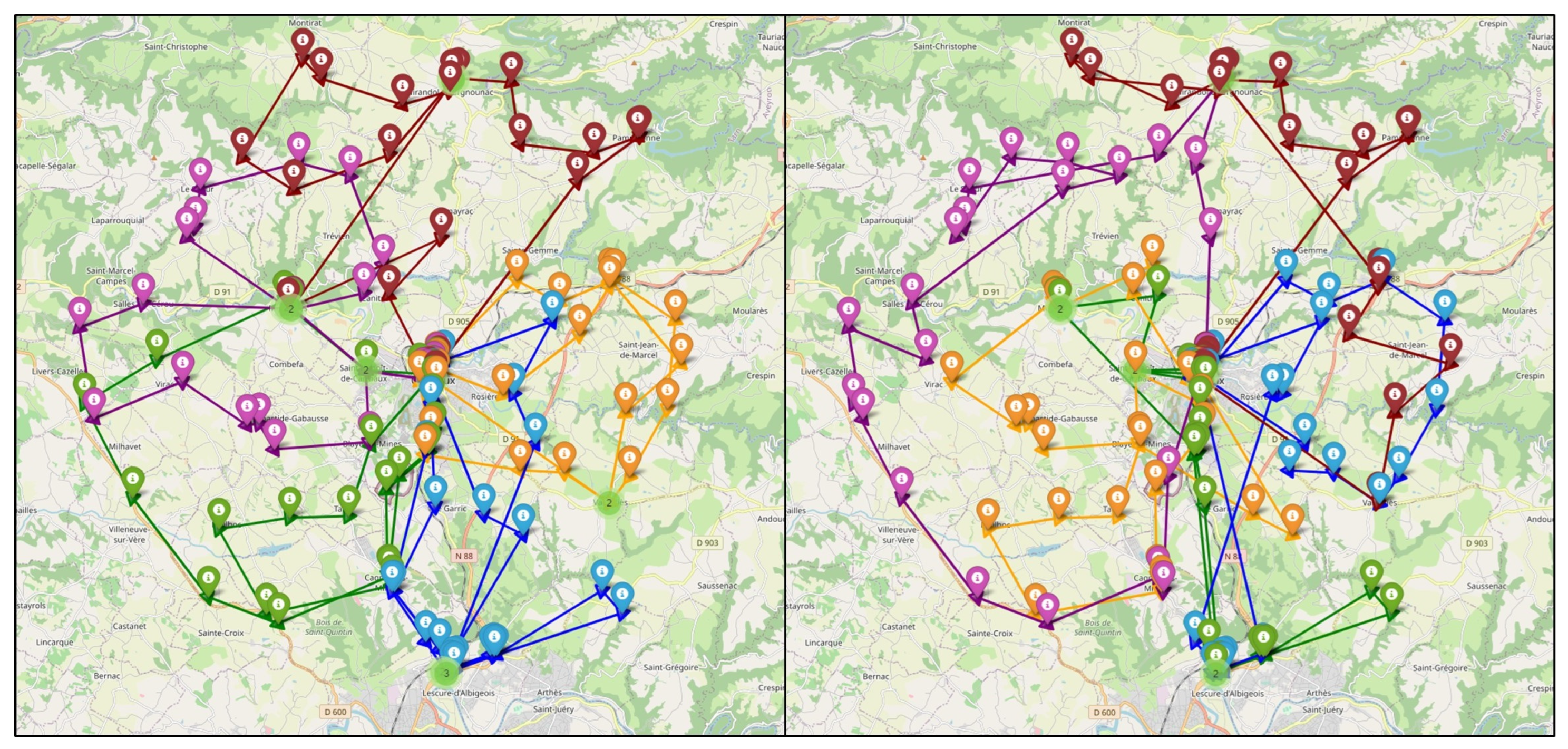
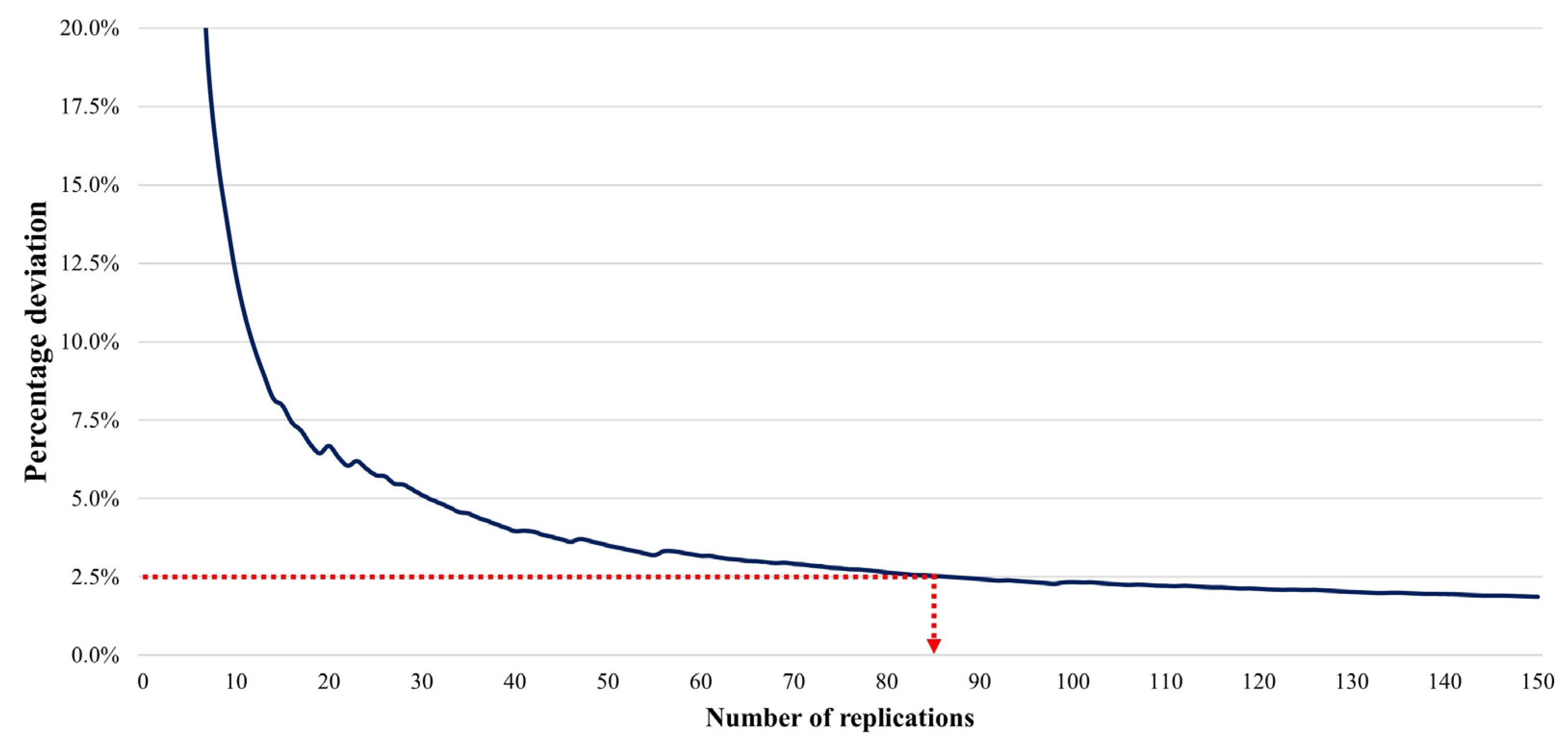
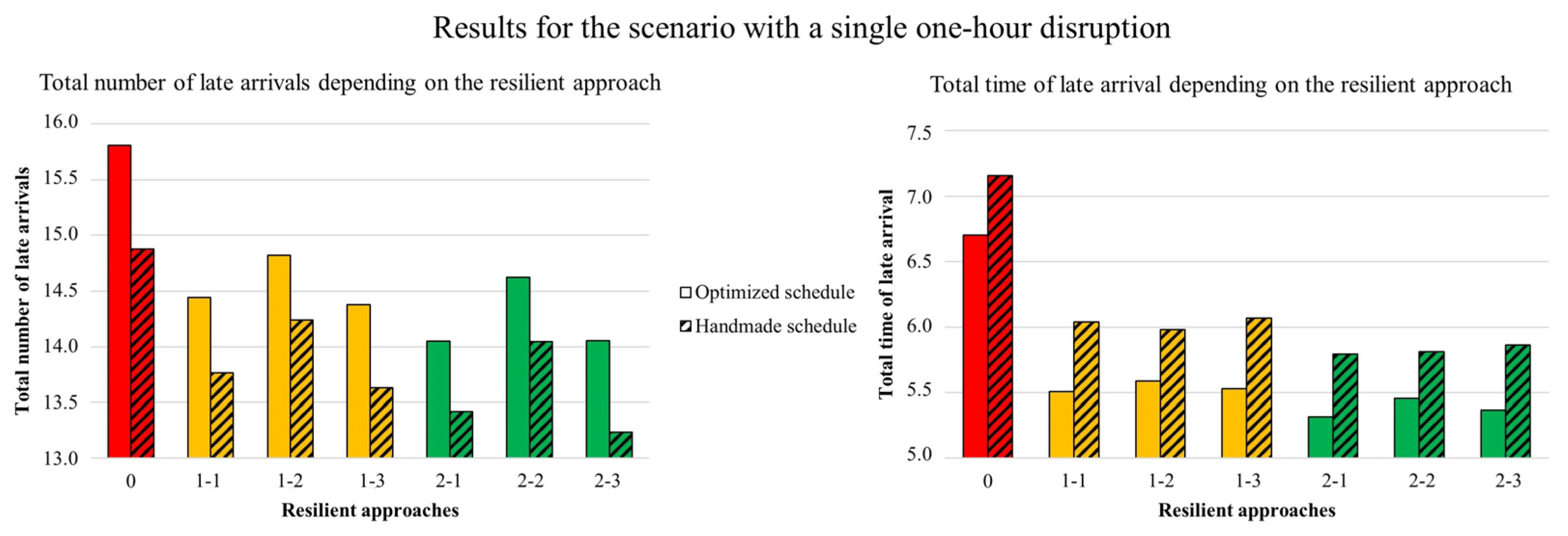
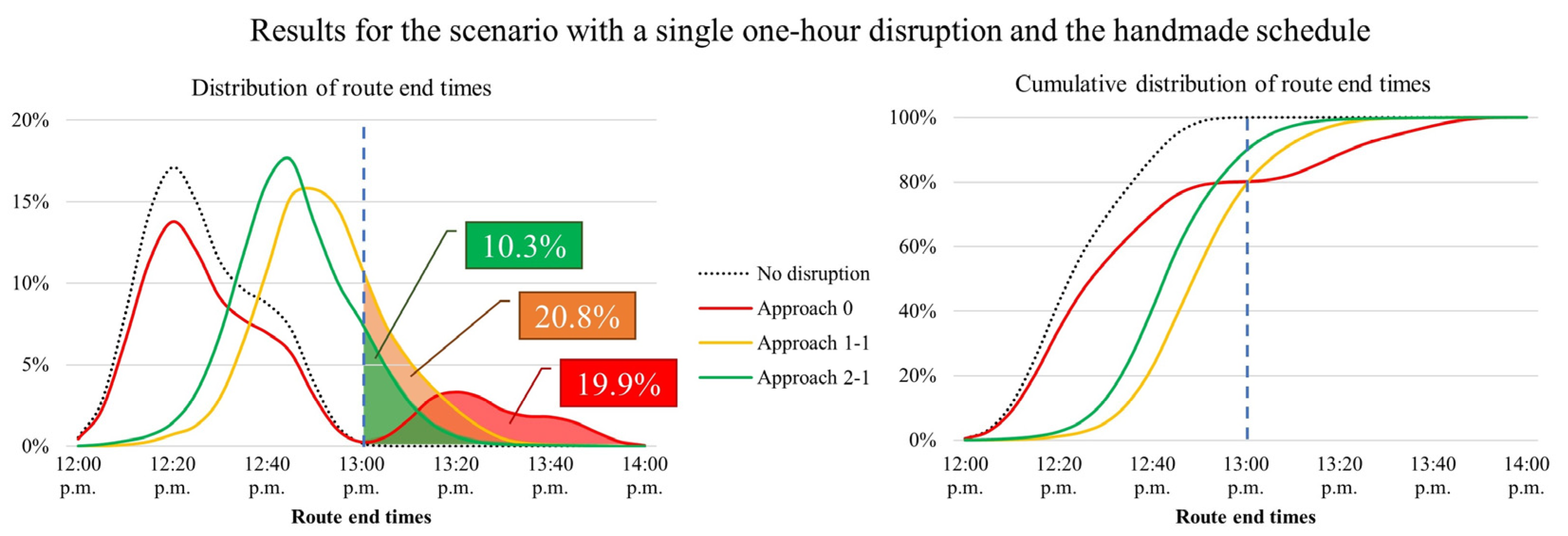
| Approaches | |
|---|---|
| 0 | Baseline (not a resilient approach) |
| 1-X | Distributed collaborative approach (existing) |
| 2-X | Centralized collaborative approach (innovative) |
| Sub-approaches | When I help a colleague, which care visit should I take? |
| X-1 | The closest to me |
| X-2 | Next on the schedule |
| X-3 | The last of the schedule |
Disclaimer/Publisher’s Note: The statements, opinions and data contained in all publications are solely those of the individual author(s) and contributor(s) and not of MDPI and/or the editor(s). MDPI and/or the editor(s) disclaim responsibility for any injury to people or property resulting from any ideas, methods, instructions or products referred to in the content. |
© 2023 by the authors. Licensee MDPI, Basel, Switzerland. This article is an open access article distributed under the terms and conditions of the Creative Commons Attribution (CC BY) license (https://creativecommons.org/licenses/by/4.0/).
Share and Cite
Dessevre, G.; Martinez, C.; Zhang, L.; Bortolaso, C.; Fontanili, F. The Centralization and Sharing of Information for Improving a Resilient Approach Based on Decision-Making at a Local Home Health Care Center. Appl. Sci. 2023, 13, 8576. https://doi.org/10.3390/app13158576
Dessevre G, Martinez C, Zhang L, Bortolaso C, Fontanili F. The Centralization and Sharing of Information for Improving a Resilient Approach Based on Decision-Making at a Local Home Health Care Center. Applied Sciences. 2023; 13(15):8576. https://doi.org/10.3390/app13158576
Chicago/Turabian StyleDessevre, Guillaume, Cléa Martinez, Liwen Zhang, Christophe Bortolaso, and Franck Fontanili. 2023. "The Centralization and Sharing of Information for Improving a Resilient Approach Based on Decision-Making at a Local Home Health Care Center" Applied Sciences 13, no. 15: 8576. https://doi.org/10.3390/app13158576
APA StyleDessevre, G., Martinez, C., Zhang, L., Bortolaso, C., & Fontanili, F. (2023). The Centralization and Sharing of Information for Improving a Resilient Approach Based on Decision-Making at a Local Home Health Care Center. Applied Sciences, 13(15), 8576. https://doi.org/10.3390/app13158576






